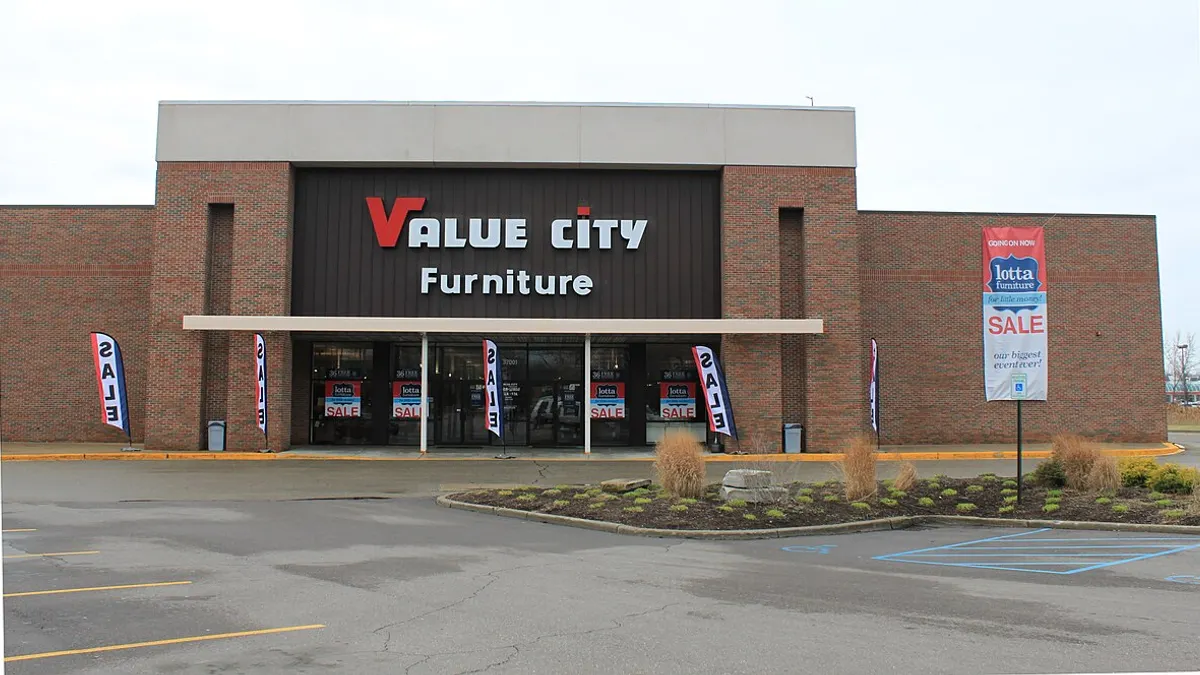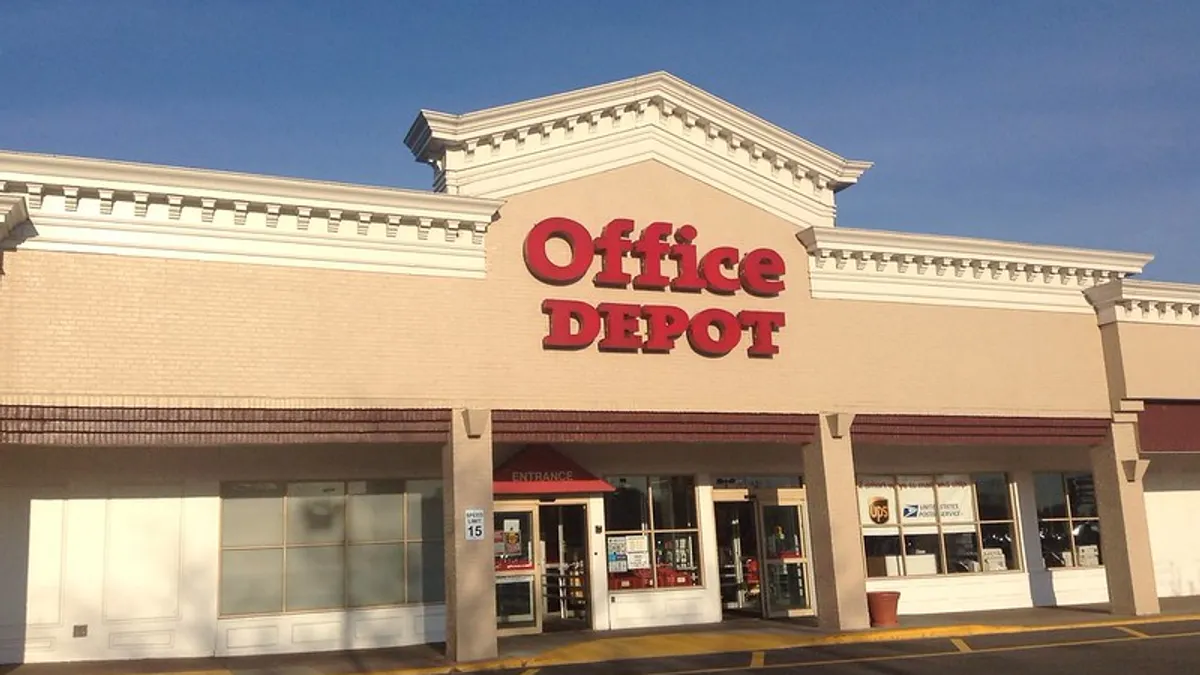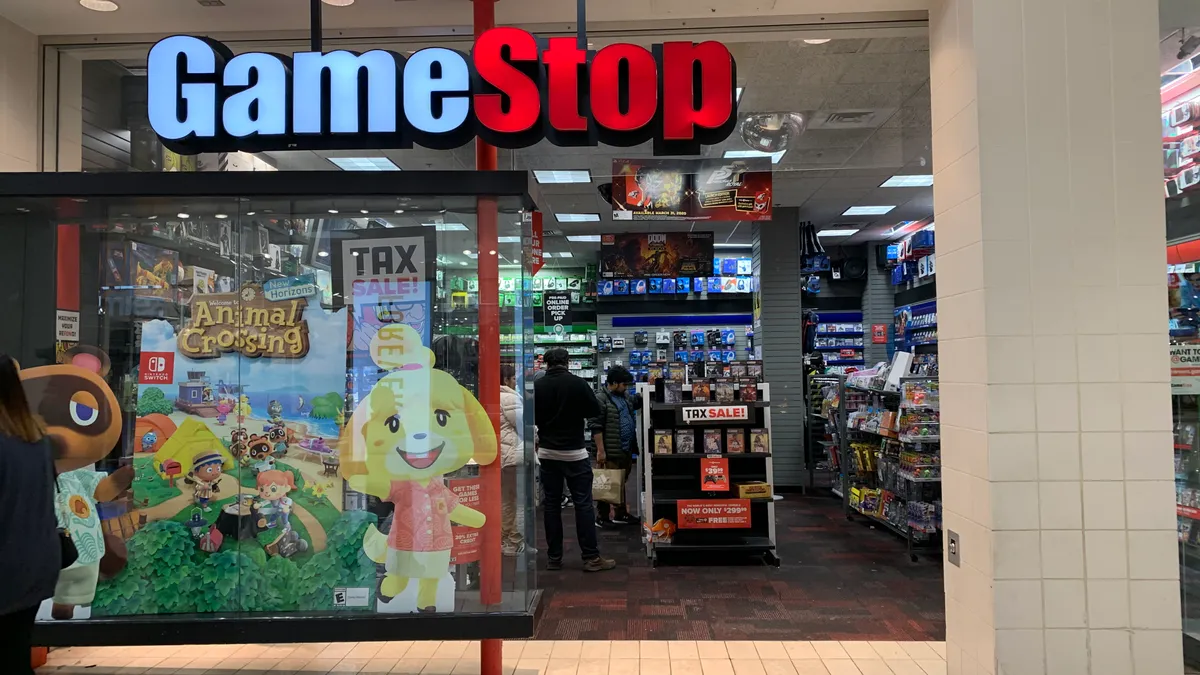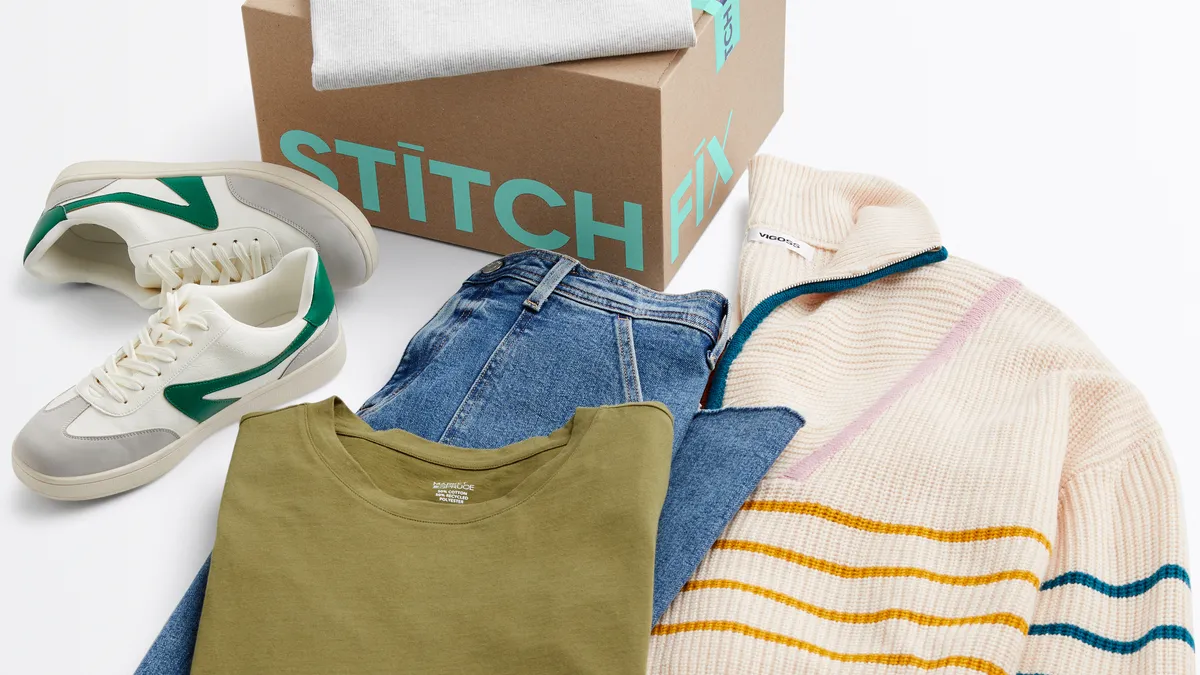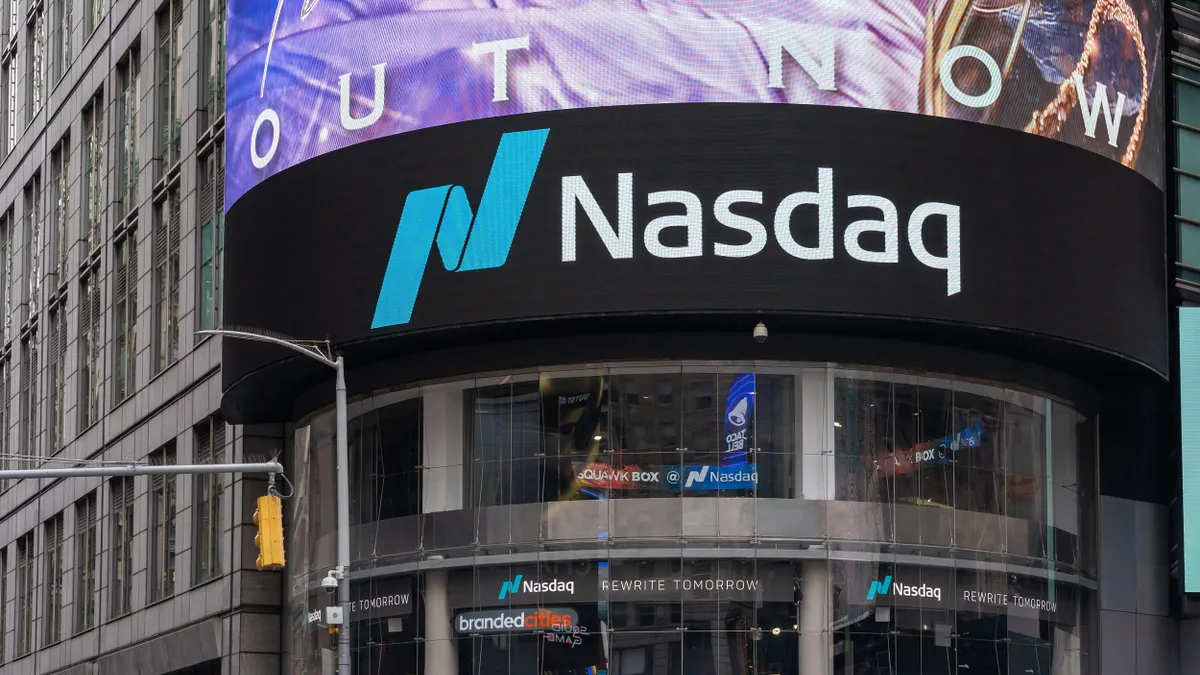Gap Inc. on Thursday joined rival apparel retailers in drafting on the smooth-sailing economy, posting an 8% second-quarter net sales rise to $4.1 billion, and its seventh consecutive quarter of comp gains at 2%. But the story was familiar: Old Navy bolstered results with its third straight quarter of same-store sales increases.
The downfall of the company's flagship Gap brand, once a definer of style for casually well-dressed Americans, has persisted to the point where, last year, executives retooled their growth strategy toward greater dependence on the lower-priced banner. Meanwhile, the company's athleisure Athleta brand is showing promise and a capacity for growth, and even its struggling Banana Republic label rang up a 2% comparable sales rise — its third straight comp gain after falling 5% in the year-ago quarter.
Gap Inc. didn't respond to Retail Dive's request for an interview for this story. But executives last week promised on their earnings call that the Gap brand's results were poised to improve in the second half of the year, as low-performing inventories cleared out and new chief Neil Fiske had more of a chance to make his mark. But the company's strategy looks increasingly like one that's giving up on its flagship.
"The thing about Gap Inc. as a whole is that it's a very timid, play-it-safe company — and oftentimes it yields failure," warned GlobalData Retail Managing Director Neil Saunders in an interview with Retail Dive.
Athleta's working out
Gap Inc. acquired Athleta a decade ago, but the banner has recently come into its own amid a rise in athleisure that shows little sign of slipping.
"[Athleta] delivered another market share-gaining quarter and is progressing well against our $1 billion sales objective," CEO Art Peck said, according to a transcript from Seeking Alpha. "This brand continues to excel in engaging and connecting with new and existing customers, and in Q2 the new customer growth rate continued to accelerate, a sign of a healthy, solid growth brand."
Athleta is resonating especially with tween girls, with campaigns such as its back-to-school marketing centered on a "Stay in the Game" campaign encouraging girls in elementary and middle school to play sports and lead active lives. And like Old Navy, it's adding new stores.
But the brand may be playing it a bit too safe, according to Saunders, who noted that, unlike Lululemon, Athleta hasn't ventured into menswear. "It's rather like the Gap brand itself — it's a very dull, very boring company and in this type of market that isn't enough."
And to the Republic
For a while it seemed like Banana Republic was the banner in Gap Inc.'s stable that might fade away.
Last year the apparel retailer, first acquired by Gap in 1983 under the leadership of then-CEO Mickey Drexler, was in freefall. U.S. sales had fallen 16% over the previous three years, the company the year before shuttered all of its U.K. stores and longtime chief Andi Owen left. Under the new growth strategy, the plan is to shutter about 200 underperforming Gap and Banana Republic stores over the next three years, and that pull-back has begun. The brand still racks up plenty of sales, but its downturn has some observers wondering if it should become a sub-brand of the flagship, or be left to die altogether.
But things have perked up in recent quarters, and executives last week told analysts not to count it out. "I believe Banana has growth that nobody really appreciates, because Banana plays as a specialty brand," Peck said last week, noting that that label competes mostly with premium department store apparel. "I think we have a good share opportunity right now, it's not like the entire department store sector is driving at the moment."
On the same call, Chief Financial Officer Teri List-Stoll suggested that Banana Republic could eventually even be counted on for growth. "I wouldn't downplay the benefit of Banana on a rebound," she said.
But it's no time for complacency, and Banana Republic has only made tentative gains, according to some analysts. "There does appear to be a light at the end of the tunnel Banana Republic has long been in," Ray Hartjen, director of marketing for store analytics group RetailNext, told Retail Dive in an email. "To ensure that light isn't the front of an oncoming train, though," Hartjen said, Banana Republic has work to do.
To succeed, Banana must regularly take the pulse of its customers (and listen to them), advance its blended online/offline shopping experience, and continue to right-size the number — and size — of its stores, according to Hartjen. And it's also about the merchandise, he said. "Banana is leaving some margin on the table. It competes with the UNTUCKITs [sic] of the world, but ... at a considerably lower price. Secondly, Banana Republic's assortment is huge, perhaps problematically so.”
Still, the apparel is looking noticeably more stylish these days, according to Saunders. "I think they have started to make an effort," he said. "There are more edits in there that look more fashionable, more interesting."
But Saunders warned that the brand's modest comp increase in the second quarter indicates that it's too soon to declare a sustained recovery at Banana Republic. And even then, Gap Inc.'s future, in the absence of a rebound in its flagship, is pegged to Old Navy. "Gap, Inc. won't soar on the basis of strong Banana Republic results," Hartjen said. "There's just not that scale in the overall company portfolio. Gap rises and falls on the merits of Old Navy and its namesake brand."
Good old Old Navy
It's hard to argue with success, and Old Navy, except for a miss here and there in the past few years, has consistently been the company's saving grace. "Fortunately for the group, the superstar Old Navy has come to the rescue," Saunders said in his comments on the most recent quarter, calling the banner's results "the direct opposite of its troubled sister brand."
Peck has the receipts. "Old Navy grew market share again this [third] quarter and in Q2 as the eighth largest apparel retailer, second largest apparel brand in the United States. We're seeing incredible strength in brand health metrics, and Old Navy is continuing to pace towards our $10 billion net sales goal." he crowed last week, noting that store traffic is outpacing the industry and remodels are gaining traction. "We've told you this was a priority and we continue to pursue it, and, year-to-date, we've opened 28 stores and completed 85 remodels."
Old Navy isn't without its limits, however, starting with its cheap prices. Drexler in 1994 devised the banner to retain customers who were gravitating from Gap to cheaper denim being found at places like J.C. Penney and Target. "Old Navy is what it is, and over the life of the brand, it's been a solid performer," Hartjen said. "Its limitations are in its discount niche, but thus far, it's played that niche almost flawlessly."
That includes nice turnover of merchandise so there's always newness, stylish basics and a wider customer base that now includes older people and families and not just young people, according to Saunders.
But there's also risk in all those stores. "Its store expansion does have some limits," Saunders said. "There's definitely headroom for growth in the U.S. and, while there's no way they can keep having these same type of results, it's doing well for the moment."
Bridging the Gap
Gap Inc. may be trying to span the crevices created by the uneven quality of its portfolio by spreading loyalty rewards across its four major units, Gap, Old Navy, Banana Republic and Athleta. Dubbed "Bright," the program has added all of California to last year's tests in Dallas and Atlanta.
"[O]ur cross-brand customers are 10 times more valuable to Gap Inc. in one year than a 'one and done' shopper," spokesperson Christopher Cooney said in an email to Retail Dive. "This program is key in delivering against growing that customer base of loyal shoppers."
It could pay off. Gap's siblings get some high marks, even from younger shoppers. Among 13- to 39-year-olds, Old Navy ranks sixth among 66 fashion, apparel, and retail brands tracked by Ypulse's Ybrands survey, emailed to Retail Dive. Banana Republic ranks 41st, but both enjoy strong awareness: Old Navy with 97.7%, and Banana Republic with 84.6%, (though 21.7% say they're "loyal" to Old Navy, versus 7.7% for Banana Republic).
But all that could signal yet more trouble for Gap itself. Old Navy's share has been increasing over the past four years, while Gap declined by 5% and Banana Republic 7%, according to data from 1010data emailed to Retail Dive. From October 2016 to September 2017, 54% of Gap's customers also shopped at Old Navy, and just 19% also shopped at Banana Republic. Meanwhile, as Gap falls, Old Navy rises: 38% of Gap's lost customers go to Old Navy, according to 1010data.
Perhaps that's because Gap has lost much of its very identity to its low-price sibling. As Jeffries analyst Randy Konik put it during last week's conference call, "[I]t's hard for me to tell between Gap and Old Navy at this point."
That's a terrible place for a once-iconic brand to be in, especially when it's the one demanding higher prices. But, in the absence of dramatic change, that sense will only grow, Saunders warned. "Gap has always said, 'We're making changes,' but, sorry, I can't see any difference from five years ago, 10 years ago, 20 years ago," he said. "The brand is very confused, so they have a long way to go because it's still struggling for relevance."
The trouble is — despite Old Navy's very real strengths, Gap's history, the promise of its other banners and its solid financial position — some of what's hindering its flagship is true for Gap Inc. overall, Saunders said. "It is still a very big company [including] in terms of volume of sales, but the problem is that it's very unambitious," he said. "Even with Athletica, even with Banana Republic and even with Old Navy."










